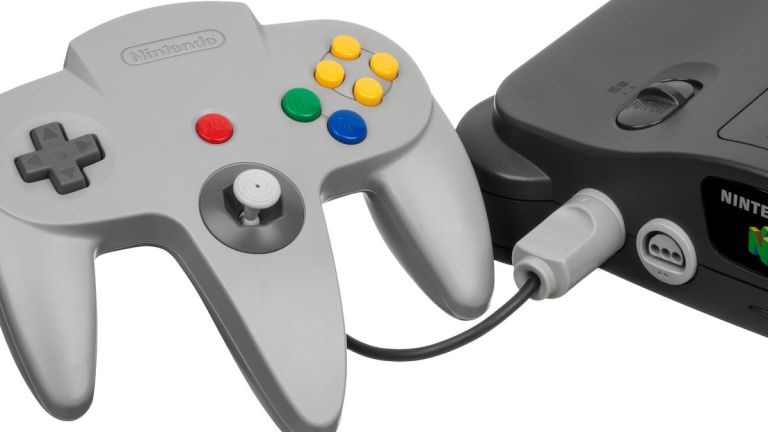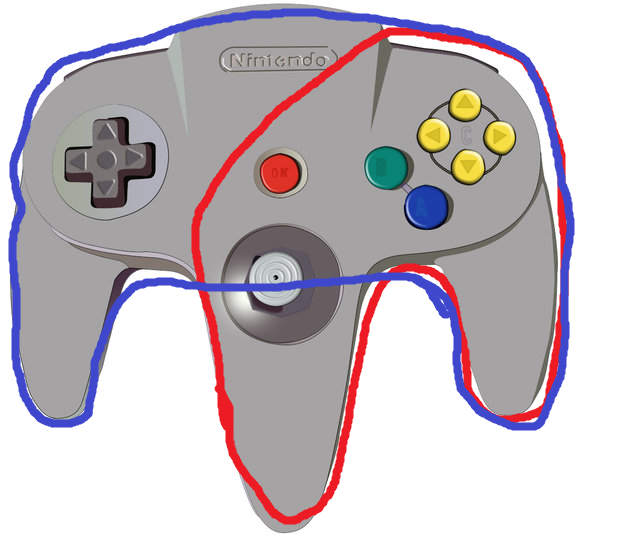Why the N64 Controller Design Was So Weird
The story of the N64 controller's design is even weirder than the controller itself.

There’s a lot to be said about the 25-year history of the Nintendo 64, but one question that almost always seems to come up in any conversation about the console is “Why was the N64 controller so weird?”
Mind you, that isn’t to say that the N64 controller was necessarily bad. There are certainly some who will make that argument, but others consider it to be one of their favorite video game controllers ever. Whichever side you fall on, though, you’ll probably agree that the N64 controller was simply bizarre from a design perspective. There wasn’t really a controller like it before 1996, and there really hasn’t been a controller like it since.
The N64’s trident (or “Batarang,” as some call it) shape and somewhat strange A, B, and C button layout are certainly unusual, but when most people talk about the N64 controller being “weird,” they’re typically talking about the analog stick and Z-trigger placement. For a modern generation of gamers raised on the idea of being able to easily access a D-pad, analog sticks, and buttons at the same time (or, you know, anyone who grew up with the PS1 Dual Analog/DualShock controller instead), picking up an N64 controller for the first time must feel like a prank.
In fact, you could probably pull off a “Calvin’s dad” style joke and convince some very young gamers that the N64 controller looks the way it does because most people back then had three hands. It’s almost like Nintendo took two perfectly good controllers and decided to fuse them together as part of their attempt to form a kind of Megazord controller.
You know what’s really funny, though? That’s actually pretty much exactly what happened.
First off, you may have heard that the N64 controller was designed to play Super Mario 64. However, that’s not entirely true. Various Nintendo representatives over the years (including Shigeru Miyamoto) have stated that the design of the N64’s controller and Super Mario 64 essentially influenced each other rather than one solely informing the other. As Super Mario 64 programmer Giles Goddard once put it, “It wasn’t so much that controller dictated Mario 64, it was just that was the game [Miyamoto] was working on. Mario was the way of testing it out.”
That being said, the emergence of 3D gaming very much influenced the design of the Nintendo 64 controller and Nintendo’s decision to use an analog stick. While the N64 wasn’t the first video game controller to feature such a “joystick,” it was the first controller to emphasize the idea that joysticks were going to be the best way to move characters around a 3D space and afford players the range of motion that kind of environment requires.
So why didn’t Nintendo just put the joystick on the left side of the N64 controller (like we saw with the Dreamcast) or give players two joysticks to use in unison (like the PS1 Dual Analog controller eventually did)? Well, we don’t know if Nintendo even considered those specific designs at some point, but we do know that part of the reason they didn’t position the analog stick in a way that let you easily use it along with every other available button on the N64’s controller is that they felt that may softly force developers to use it.
See, Nintendo knew that 3D gaming was going to be a big deal, but reports suggest they ultimately felt that most upcoming games were either going to be 2D, 3D, or, in rarer cases, a combination of both concepts. As such, they wanted to make a controller that was essentially two controllers: one made more for 2D “16-bit” games and one for 3D “64-bit” games. It’s a little strange to think about, but this wonderful MS Paint demonstration from Reddit user rg44_at_the_office does an excellent job of illustrating the concept:

As you can see, the “blue” controller is a pretty standard design that Nintendo suspected you would use to play more 2D-like games. You held it like a “normal” controller and used the D-pad along with the face buttons and L and R shoulder buttons. Meanwhile, the “red” controller is the one Nintendo designed for 3D games. It’s essentially a sideways version of a more standard controller. This layout essentially replaces the D-pad with the analog stick and replaces the L shoulder button with the Z-trigger.
Interestingly, those aren’t the only controller layouts that developers eventually utilized. Some games allowed for a third configuration designed to allow you to use the D-pad and analog stick in conjunction (with the Z-trigger now replacing the R shoulder button rather than the L shoulder button). A few games (most notably Perfect Dark and GoldenEye 007) even let you use two N64 controllers in conjunction with each other for a strange take on the “dual analog” experience.
To be fair the idea of offering developers that kind of hardware flexibility at a time when the bridge between 2D and 3D gaming was still being built probably sounded like a good one. However, Nintendo’s good intentions were eventually undone by a few emerging practicalities.
First off, not many games exclusively used the “blue” controller layout. Kirby 64 is the most famous N64 game I can think of that relied exclusively on the D-pad for movement, and even then, developer HAL Laboratory initially intended to use the “red” layout for that game before they saw how awkward it was for children to hold the controller in that way. There also weren’t a lot of games that really offered you the option of using either the D-pad or the analog stick layout (or both in conjunction), and those that did usually struggled to make the whole thing work.
Most importantly, Nintendo’s design was based on the idea that gamers would rarely need to access all of the N64’s buttons at once. However, it soon became clear that 3D games were evolving to require (or heavily benefit from) the use of as many input options as possible. While quite a few N64 developers obviously figured out how to work around the N64 controller’s design, you only have to imagine trying to play something like Ape Escape or even a “next-gen” game like Halo on an N64 controller to appreciate how limited the N64’s controller design ultimately was.
In short, the N64 controller was so weird because Nintendo tried to use it to satisfy two wildly different styles/eras of game design equally. While you could argue that they underestimated how quickly things were evolving and may have been better off going with the dual analog set-up, it has to be said that it’s hard to play a game designed specifically for the N64 controller on any other peripheral and have it feel anywhere close to the “intended” experience.
